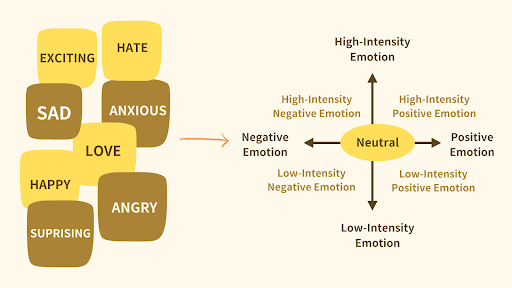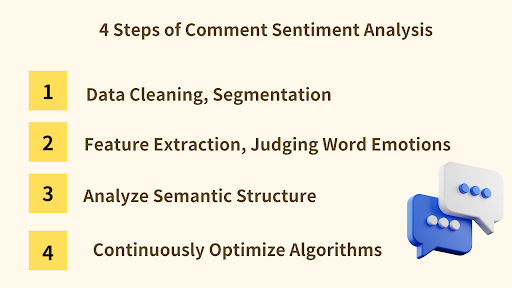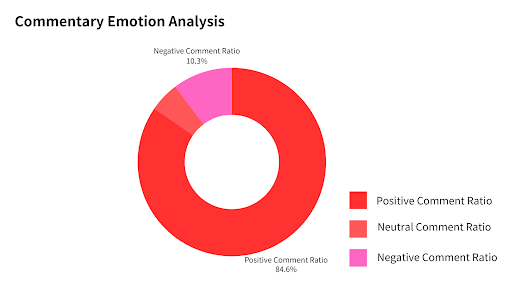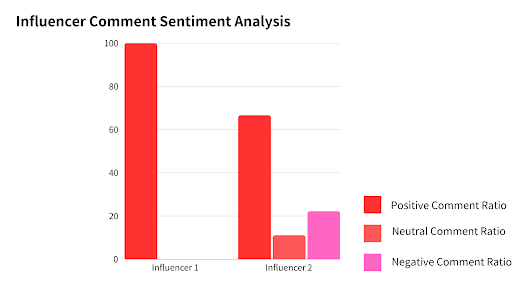With the increased volume of brands and influencer collaboration posts, having effective monitoring tools can help brands quickly review the effectiveness after each collaboration. However, sometimes high volume does not necessarily represent the success of a collaboration post. If a public relations crisis arises during the collaboration post’s online period, the high traffic caused by a burst of negative comments cannot be considered as valid data. Therefore, in addition to analyzing the volume data brought by influencers, observing comment sentiment can help brands comprehensively understand influencer marketing feedback and reputation to formulate marketing strategies that are closer to market demands.
KOL Radar utilizes top AI web crawling technology and AI natural language analysis models to offer a Comment Sentiment Analysis feature within the Deep Report function exclusive to KOL Radar’s business version. This feature reflects the true sentiment of the comments and effectively solves the quantity over the quality problem of the data collected. How does Comment Sentiment Analysis work exactly? In this article, we will explain step by step the principles behind the AI’s operation and help you have a clearer understanding of the importance of comment sentiment and the reason why it should be observed.
AI Comment Sentiment Analysis is an application of Text Sentiment Recognition. What is Text Sentiment Recognition?
The main goal of text sentiment recognition is to identify emotions in words, sentences, and articles, such as positive, negative, and neutral emotions. Through AI machine learning, deep learning models, and natural language processing techniques, AI can break down complex text structures and analyze the emotions behind texts.
The applications of text sentiment recognition are diverse, and here are some examples:
- Political Purposes: Used to detect trends in public opinion and improve the accuracy of polls.
- Benefit Evaluation: Analyze user comments to evaluate the effectiveness of marketing activities and community trends.
- Book Classification: Classify physical or electronic books based on content to help the system categorize related books with similar content.
- Entertainment Purposes: Analyze emotions behind lyrics and suggest emojis after the text is typed.
So, What Is Comment Sentiment Analysis?
Comment sentiment analysis specifically refers to using AI text detection technology to determine the emotional tone of the comments under a post and judge whether users’ thoughts on the post are positive, negative, or neutral. In fact, emotions can be broadly categorized into eight types: expectation, joy, love, surprise, anxiety, sadness, anger, and hatred. However, depending on different purposes and training models, these emotions can be further subdivided into more categories or some of these categories can be merged.
KOL Radar’s AI language training model text sentiment v1.1.2 first extends emotions to more than ten types and then reduces the analysis results to positive, neutral, and negative emotions. Then, it further divides positive and negative emotions into four quadrants based on word intensity, as shown in the figure below:

Resource: KOL Radar
What are the Steps of Comment Sentiment Analysis?

Step 1: Data Cleaning, Segmentation – Organizing messy text into a format recognizable by the system
Before addressing a problem, it is necessary to break it down. Therefore, before AI processes a complete sentence, it will first break it down into multiple words and classify them based on parts of speech, selecting body words and predicate words that can identify the key message of the sentence. Meaningless particles, such as “oh,” “ah,” “eh,” “hey,” etc., are removed.
Body words include nouns, pronouns, numerals, classifiers, etc., while predicate words are verbs, adjectives, etc. Both are the core elements of sentence composition and are more representative of sentence emotions.
Step 2: Feature Extraction, Judging Word Emotions
Feature extraction refers to extracting features from the segmented word sequences that can help the machine identify the emotional features of the sentence. After feature extraction, AI can simulate human neural networks based on machine learning, deep learning models, and natural language processing techniques to classify comments as having positive, neutral, or negative emotions based on settings.
In addition to words, punctuation can also be used to distinguish emotion. However, punctuation is not used to classify positive, neutral, or negative emotions but to determine the strength of emotions. For example, a weak negative sentence with an exclamation mark will be classified as a strong negative sentence.
In contrast to emotion analysis in articles, “emoji” is a very special element in comment sentiment analysis. The general emotion classification of emoji is shown in the figure below:

Step 3: Analyze Semantic Structure
After distinguishing the emotions of multiple words in a sentence, the next step is to combine the words and use semantic analysis to enhance word emotion judgment. The following examples will explain negation semantics, reversal semantics, and connective semantics.
(1) Negation Semantics
Adding a negation word in front of a word will change the overall sentiment of the sentence to a negative one. Common negation words include 不 (not), 不可 (not allowed), 不可以 (cannot), 不得 (must not), 不許 (not allowed), 不能夠 (cannot), 不能 (cannot), 不行 (cannot), 不准 (not allowed), 不必 (not necessary), 不用 (do not need), 不要 (do not), 不會 (will not), 不想 (do not want), 無需 (not required), 並非 (not), 從不 (never), etc. However, it is essential to pay attention to double negation. For example, “I hate Influencer A” is a negative emotion, but “I can never hate Influencer A” is positive. This is because “hate” is a negative verb and “never” is a negation word. In the case of a double negative, the AI model will classify “I can never hate Influencer A” as a positive emotion.
(2) Reversal Semantics
If there are reversal words before and after a word, it may cause some changes in what the sentence is trying to express. For example, “It’s raining today, and I didn’t bring an umbrella.” is a neutral sentence, but adding the reversal word “fortunately” transforms the sentence into “It’s raining today, and I didn’t bring an umbrella, fortunately, a friend lent me one! I feel so lucky!” and changes it into a positive emotion. Although reversal words can affect the development of sentence semantics, not all reversal words will change the emotion. Common reversal words include 終於 (finally), 居然 (unexpectedly), 幸好 (fortunately), 幸虧 (fortunately), 還好 (fortunately), 竟然 (unexpectedly), 可是 (but), etc.
(3) Connective Semantics
Connectives are usually used to connect coherent or non-conflicting words or sentences. So, adding connectives after a sentence usually does not result in significant changes in emotion. Common connectives include 或是 (or), 以及 (and), 同等於 (equivalent to), 例如 (for example), 換句話說 (in other words), etc.
Step 4: Continuously Optimize Algorithms – Train the Model Analysis Results to Be More Accurate
After the analysis results are obtained, they are usually filtered via manual screening first to confirm the accuracy of the analysis results. After correction, AI will undergo deep learning and optimize the analysis results through extensive data. It then classifies more words and sentences into positive, negative, and neutral emotions, integrates recognition, and ultimately produces an algorithm that covers most situations.
Of course, AI text sentiment analysis is not always 100% accurate. But over time, the analysis system will become more and more complete. Through continuous machine learning training to optimize analysis accuracy, an analysis system with high accuracy in comment sentiment analysis can be developed.
- Can All Comments Be Classified as Positive or Negative? What Are the Challenges? Ironic Sentences Increase Difficulty in Judgment
Text lacks the expression of tone compared to spoken language. Therefore, many comments that initially appear positive can, upon closer inspection, mean the exact opposite. For example, “I really like him ==” actually means “I don’t like him,” “This video is so funny ??” means “I don’t understand the humor of this video,” and “I really couldn’t agree more:)” actually means “I don’t quite agree.”
- The System Needs to Continuously Update Itself on Internet Slangs and Trending Vocabulary
Many trendy terms are developed by combining English, Chinese, and Taiwanese. For example, the four English letters Y, Y, D, S do not convey any emotion on their own, but “yyds” stands for the initials of the English words “Forever God” and conveys a positive emotion, such as “Lin Bao-Hong yyds.” Additionally, the term “狠” (hen) initially seems negative, but it can also be used to convey admiration, so “太狠了” can be both negative and positive. Therefore, the analysis system needs to continuously add the latest trending terms to judge and make the most accurate sentiment analysis.
- Many Emoji Have Implicit Meanings That Lead to Misjudgment
Every culture has implicitly understood special words, and emojis also have many interpretations beyond the pictures they represent. For example, ? (smile) is positive, but sometimes it can mean a sly smile, a contemptuous smile, a perfunctory smile, etc., conveying negative emotions.
In summary, having a well-defined, recognizable, and comprehensive recognition system that covers all sentence situations is crucial. Only through continuous machine learning training optimization can a comment sentiment analysis system with high accuracy be developed.
Why Should Audience Comment Sentiment Be Valued? What Can Different Comment Sentiment Indicators Represent?
1. Gauge the Audience’s Acceptance for Sponsored Content Quantity
After publishing posts about a certain collaboration, brands can observe the volume, promotional effectiveness, and other social influence brought by the series of posts to gauge the acceptance level and effectiveness feedback of fans for the collaboration posts during that period.

Source: KOL Radar
2. Observe Which Form of Posts Aligns with the Public’s Preferences
If a brand collaborates with multiple influencers simultaneously, it can observe and summarize the comment sentiment ratios of different influencers. This allows brands to adjust the direction of future posts by identifying which posts resonate more with fans, which posts are more favored, and which posts receive lower negative feedback.
3. Comparing Audience Perceptions of Posts Across Platforms
With the integration of Meta’s cross-platform functionality, many creators simultaneously publish posts on both Instagram and Facebook. However, based on past cases, there are differences in audience feedback between the two platforms.

Source: KOL Radar
Conclusion
For the average person, it usually takes 3 to 5 minutes to read comments from friends and family. However, for brand owners observing influencer marketing posts with large traffic, it may take a bit more time to read all comments. In situations where there is a massive number of comments, Comment Sentiment Analysis helps users quickly assess the overall effectiveness of the article. It is an indispensable tool for influencer marketing!

If you would like to further understand influencer marketing, feel free to consult KOL Radar for free at https://www.kolradar.com/en/solution.
▶︎ This article may not be reproduced, reprinted, publicly broadcast, or publicly transmitted without permission. The copyright and image rights of the pictures and data referenced in this article still belong to their respective owners.



